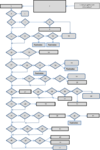
Difference between revisions of "Design Sequence Flowchart-Flexible treatment options"
Dfairbairn (talk | contribs) m |
m (→Related pages) |
||
| (2 intermediate revisions by the same user not shown) | |||
| Line 1: | Line 1: | ||
| − | [[File:Wiki flow chart sequence.png|100px|thumb|alt=image of flow chart used for wiki|<font size=4>[ | + | [[File:Wiki flow chart sequence.png|100px|thumb|alt=image of flow chart used for wiki|<font size=4>[https://stormwater.pca.state.mn.us/index.php?title=MIDS_design_sequence_flow_chart Launch flow chart]</font size>]] |
If an applicant is unable to achieve the full [[Performance goals for new development, re-development and linear projects|Performance Goal]] due to site restrictions as attested by the local authority and documented by the applicant, the Flexible Treatment Options Approach shall be followed in the sequence below and through the MIDS Design Sequence Flow Chart. | If an applicant is unable to achieve the full [[Performance goals for new development, re-development and linear projects|Performance Goal]] due to site restrictions as attested by the local authority and documented by the applicant, the Flexible Treatment Options Approach shall be followed in the sequence below and through the MIDS Design Sequence Flow Chart. | ||
| Line 8: | Line 8: | ||
There are a variety of conditions that must be considered in determining the correct performance goal or flexible treatment option. For example, in many places in Minnesota bedrock is close to the land surface, soil infiltration rates are very low, karst bedrock exists, or soils may be contaminated. Each of these conditions can limit the ability to implement infiltration BMPs. | There are a variety of conditions that must be considered in determining the correct performance goal or flexible treatment option. For example, in many places in Minnesota bedrock is close to the land surface, soil infiltration rates are very low, karst bedrock exists, or soils may be contaminated. Each of these conditions can limit the ability to implement infiltration BMPs. | ||
| − | The MIDS workgroup developed a [ | + | The MIDS workgroup developed a [https://stormwater.pca.state.mn.us/index.php?title=MIDS_design_sequence_flow_chart flow chart] to help determine the appropriate goal at a development or redevelopment site. |
[[File:Final_MIDS_Flow_chart.pdf|Flow chart]] | [[File:Final_MIDS_Flow_chart.pdf|Flow chart]] | ||
| Line 35: | Line 35: | ||
#[[Overview of Minimal Impact Design Standards (MIDS)]] | #[[Overview of Minimal Impact Design Standards (MIDS)]] | ||
#[[Performance goals for new development, re-development and linear projects]] | #[[Performance goals for new development, re-development and linear projects]] | ||
| − | #[ | + | #[https://stormwater.pca.state.mn.us/index.php?title=Design_Sequence_Flowchart-Flexible_treatment_options Design Sequence Flowchart-Flexible treatment options] |
#[[Community Assistance Package]] | #[[Community Assistance Package]] | ||
#[[MIDS calculator]] | #[[MIDS calculator]] | ||
| Line 41: | Line 41: | ||
#[[Technical documents]] | #[[Technical documents]] | ||
| − | [[Category:MIDS]] | + | [[Category:Level 2 - Management/MIDS]] |
</noinclude> | </noinclude> | ||
Latest revision as of 23:36, 6 December 2022
If an applicant is unable to achieve the full Performance Goal due to site restrictions as attested by the local authority and documented by the applicant, the Flexible Treatment Options Approach shall be followed in the sequence below and through the MIDS Design Sequence Flow Chart.
Contents
Design sequence flow chart
There are a variety of conditions that must be considered in determining the correct performance goal or flexible treatment option. For example, in many places in Minnesota bedrock is close to the land surface, soil infiltration rates are very low, karst bedrock exists, or soils may be contaminated. Each of these conditions can limit the ability to implement infiltration BMPs.
The MIDS workgroup developed a flow chart to help determine the appropriate goal at a development or redevelopment site.
File:Final MIDS Flow chart.pdf
Flexible Treatment Option 1 (FTO #1)
Applicant attempts to comply with the following conditions:
- Achieve at least 0.55 inch volume reduction goal, and
- Remove 75 percent of the annual total phosphorus load, and
- Options considered and presented shall examine the merits of reloacting project elements to address varying soil conditions and other constraints across the site
Flexible Treatment Option 2 (FTO #2)
Applicant attempts to comply with the following conditions:
- Achieve volume reduction to the maximum extent practicable (as determined by the Local Authority), and
- Remove 60 percent of the annual total phosphorus load, and
- Options considered and presented shall examine the merits of relocating project elements to address varying soil conditions and other constraints across the site.
Flexible Treatment Option 3 (FTO#3)
Off-site mitigation (including banking or cash or treatment on another project, as determined by the local authority) equivalent to the volume reduction performance goal can be used in areas selected in the following order of preference:
- Locations that yield benefits to the same receiving water that receives runoff from the original construction activity.
- Locations within the same Department of Natural Resources (DNR) catachment area as the original construction activity.
- Locations in the next adjacent DNR catchment area up-stream.
- Locations anywhere within the local authority's jurisdiction.
Related pages
This page was last edited on 6 December 2022, at 23:36.
